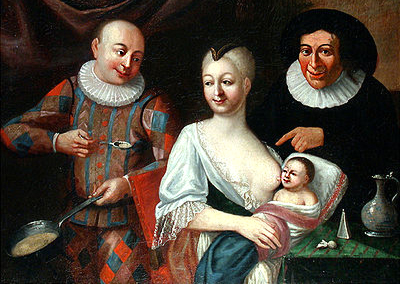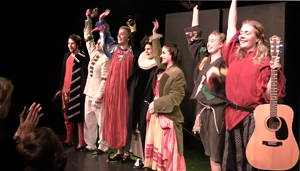
To compose a Commedia dell’Arte group was a highly delicate task. Some masks were needed in order to fill out the usual scenarios. But one couldn’t just chose the best actors. One had to think about that the actors should not just play together, they shall also live together during long tours. A corago had to build a group that harmonized together on a personal level. To judge from old letters it seems that the actors, at least in the heydays of Commedia dell’Arte, had a weakness for competing and smear each other. Besides there was factors like some actors already had rehearsed dialogs, concetti and lazzi together or that one would need particular disciplines or qualities like acrobats, singers or fatsos.
We don’t know how big, the more common, less well-to-do groups really was, but for example in the the first contract from Padua and Zan Bragetta’s groups there were 8 actors. Among the richer, more famous groups we know more. They were at least 10 – 12 actors. We can assume that, like today, the poorer groups could not afford as many actors since they all had to live from their income. Maybe that also had to do with the heritage from the bunco-steerers, the carnival sprees and the diavolas, who were all forerunners of Commedia dell’Arte.
The standard battery of masks was two Vecchi, two or more zanni, four (two couples) Innamorati, one Capitano and a Servetta. There were also small roles as soldiers, ghosts, monks, or thieves. They would either be doubled or they took help from amateurs or sometimes used family members for these roles.

To compose a Commedia dell’Arte group was one of the task of the group leader, the capocomico or the corago. The latter was the director, or at least as close to that profession one could come, while the first had the same tasks but was also an actor, like Flaminio Scala, Diana Ponti, Pier Maria Cecchini or Giovan Battista Andreini. They should also write and present new scenari, explain what was suiting in each scene, create and block sceneries and to compose the whole performance after what actors he had and their abilities.
Perrucci writes about a corago’s tasks:
“A corago, the leader or the maestro, the most competent to instruct others, shall rehearse a soggetto before it is played so the actors are familiar with the content of the performance, know when they should end their speech, and can during the rehearsal explore new jokes and lazzi. The one that has the responsibility for the rehearsal should not limit himself to reading the scenario, but explain the names and the qualities of the characters, the main content in the play, the place for the actions, the houses on the stage, the divisions of the lazzi and other necessary details, take care of the props for the play, such as letters, purses, knives, that are on the list in the end of the scenario.”
See also:
Acrobatics as a discipline in Commedia dell’Arte
Spex
Micke’s teaching